
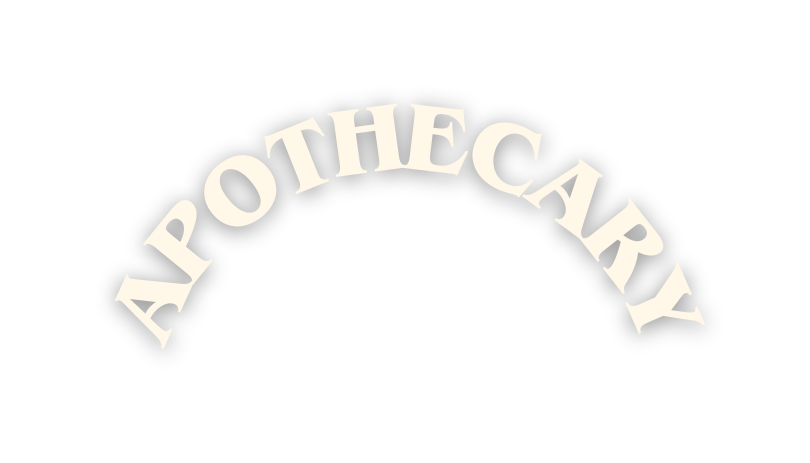

capsi umanitoba
Leadership | Advocacy | Wellness | Recipes | Pharmily
Volume 5 | pam 2024
Table of Contents
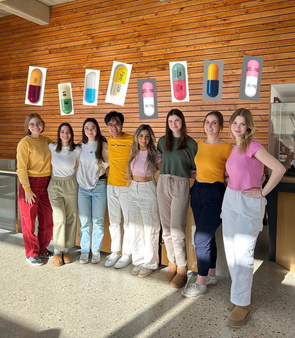
Introduction
3 | A Message From Your CAPSI Jr.
CAPSI National Advocacy Update
4 | APPE Bereavement Policy
4 | University of Toronto Reading Week
Leadership
7 | Interview with Patricia Gerber
11 | Interview with Marianna Pozdirca
14 | Interview with Matt Glass
16 | Interview with Rob Ariano


18 | Interview with Jennifer Butler
Student Spotlights
20 | Local Stars of CAPSI
Wellness
22 | Wellness Resources at UofM
23 | How are Pharmacy Students Staying Well?
Snacks
25 | Laura-Lee’s Chicken Packets
26 | Laura-Lee’s Mandarin Chicken Salad
Savoury
27 | Melissa’s Quick and Easy Turkey Burgers
28 | Melissa’s Slow Cooker Chili
29 | Corrine’s Viet Vermicelli Bowl with Lemongrass Chicken
Sweets
30 | Anushka’s Sugar Cookies
31 | Kezra’s Waffles and Vanilla Sauce
32 | Allanah’s Brown Butter Toffee Cookies
Cover photo by Corbett Cibinel Architects. Photographs by Jerry Grajewski

Introduction:
A Message From Your CAPSI Jr.
One of the most meaningful experiences in my pharmacy journey so far has been the act of building relationships and learning from the leaders that have come before me in this program and profession. It’s been my lens to gain insight on how this community ticks and what my place in it could be. The project that you’re about to read is the fruit of some seriously dedicated students’ efforts — from Christine’s first Apothecary publication, to Sim, Sandra and Kezra. Now, I’m here to welcome you to my own issue of the Apothecary, the fifth edition — a labour of love, as it turns out, for us Manitoba students. In this edition you will see that I have added a few new segments and kept many of the same segments that have been traditionally present. We have included an update on advocacy efforts held on the CAPSI National stage, a Stars of CAPSI Local segment, and a mini segment on how pharmacy students stay well! With my own passion for pharmacy growing, I wanted to highlight some topics within the profession that are close to my heart. I’m so excited to share what I’ve found with you.
This edition focuses on wisdom and insight from pharmacy leaders across Canada! Dr. Patricia Gerber from the University of British Columbia (who shares profound advice for young leaders in pharmacy), and Dr. Rob Ariano, who we know as a favourite professor at the U of M and a highly respected clinical pharmacist. Additionally, Jennifer Butler, the Vice President of Pharmacists Manitoba, and recent grads Dr. Matt Glass and Dr. Marianna Pozdirca, each highlight some important things about leadership and trusting your own instincts. Each “Question and Answer” style interview is sure to inspire you!
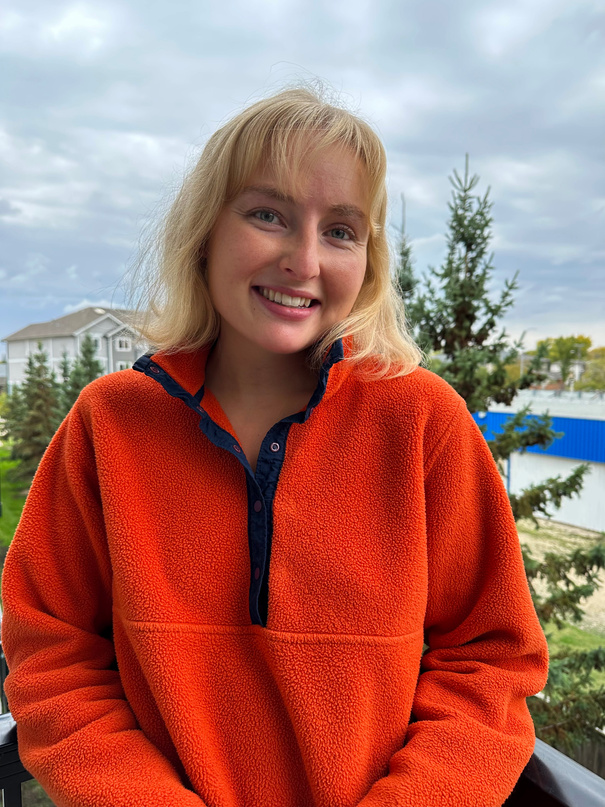
You’ll also find recipes, fun memories, student spotlights and much more within these pages. I am so happy to have shared this effort with my friend Brietta, the woman behind every visually pleasing aspect of this issue. If it weren’t for her, you’d be served this 5th edition in a plain Word doc with a possible font change thrown in here and there for mystery, and you’d be lucky to have pictures to read along with.
This project has allowed me to explore the things about pharmacy that make our community so special, and to share with you the minds of leaders who make change in big and small ways every day of their career. My goal is that you see yourself in these pages, whether that be the next winner of Canada’s Next Top Pharmacist, making a delicious waffle before your next study session or maybe even becoming a future leader of change. There’s a little something for every palate, and I hope you enjoy reading it as much as I enjoyed creating it.
-Allison Lage
Introduction | 3
Bereavement Statement 2023:
In 2023, CAPSI National released a statement addressed to all pharmacy school administrators across Canada regarding discrepancies between individual bereavement policies. It was found that students had marked differences in the allotted bereavement days available to them at their institution and whether the hours would have to be made up at another time. In the event of a loved one passing, many schools with more conservative bereavement policies would use a “case-by-case” model; CAPSI responded to this phenomenon:
“In a solely “case-by-case” model, bereavement may be afforded based on students’ individual abilities to self-advocate, their existing allies and privilege, their respective patterns of grief… and one’s comfort with sharing their grief in endeavours to evoke the compassion they should have been granted from the very beginning.”
It is clear that there is a lack of transparency in the bereavement measures implemented across Canadian pharmacy schools. It seems that a more compassionate and transparent approach is critical as students who have had a loved one pass are in no condition to advocate for themselves. CAPSI leaves the administrators with this:
“Recommendation: That each pharmacy program in Canada explicitly afford students at least two days of bereavement leave (the hours of which do not have to be made up) in each experiential education rotation block, upon a family member’s passing, without cumbersome and potentially discriminating documentation requirements, such as death certificates.”
There is ongoing discussion with CCAP occurring — CAPSI hopes to see progress on this matter soon.
See the full bereavement statement here:
https://capsi.ca/wp-content/uploads/2015/01/CAPSI-Statement-on-Student-Bereavement-Aug-26-2023-FINAL-Signed.pdf
A National
Advocacy
Update
Student Loan Forgiveness:
In 2022, CAPSI sent a letter to the federal government imploring them to consider pharmacy students, interns and licensed pharmacists as part of the Canada Student Loan Forgiveness program (CSLFP). As of November 2023, the CSLFP will forgive up to 50% of student loans of doctors and nurses who work in underserved rural or remote communities. Specifically, an forgiven amount of $30,000 for nurses and $60,000 for physicians. As of today, pharmacists are not eligible for this program.
This is a matter that CAPSI continues to pursue alongside the Canadian Pharmacists Association (CPhA), through a letter writing campaign which involves pharmacy students across Canada sending letters to their MPs in order to see more engagement in this issue on a federal level. Our initial letter reads:
“On behalf of pharmacy students, interns and pharmacists in Canada, we jointly call on the government to expand the list of eligible professionals under the Canada Student Loan Forgiveness Program to include licensed pharmacists and pharmacists in approved residency programs.”
To participate in this meaningful work of advocacy, please consider sending a letter to your MP as well. The letter can be personalized to be more specific to your MP! https://capsi.ca/wp-content/uploads/2015/01/CAPSI-CPhA-Student-Loan-Forgiveness-Letter_June-2022-1.pdf
National Advocacy |4
Student Advocacy Rotation Hours Statement 2024:
CAPSI will be releasing a statement soon in collaboration with the Indigenous Pharmacy Professionals of Canada (IPPC) regarding the implementation of time-off during rotations in order to pursue leadership and advocacy initiatives. It only makes sense when considering the types of pharmacists we want to be — movers and shakers, contributing to a scaffolding that exceeds our own benefit and holds up the integrity of Canada’s healthcare as a whole.
An excerpt from the statement reads: “Students’ lack of allotted time towards initiatives that will shape them to become a competent health advocate creates a barrier to students’ professional development as a well rounded pharmacist. Integrating advocacy into experiential rotations will allow upcoming pharmacy graduates to build skills that will play a key role in the advancement of the profession and well-being of the community.”
RECOMMENDATION: “That each pharmacy program incorporates the equivalent of at least 8 hours per month (the hours of which do not have to be made up) and permission for attendance at pharmacy board meetings and/or events for advocacy initiatives in each experiential education rotation block.”
A National
Advocacy
Update
Cont.
Other Ongoing Initiatives:
Some other school-specific initiatives that CAPSI has been involved in include the implementation of a reading week for the University of Toronto program. Ongoing discussions in wellness and advocacy subcommittees are happening surrounding fine tuning the structure of the new PharmD program at University of Ottawa (who accepted their first class of students this academic year of 2023-2024), and fees for student licensing throughout school terms at Memorial University of Newfoundland.
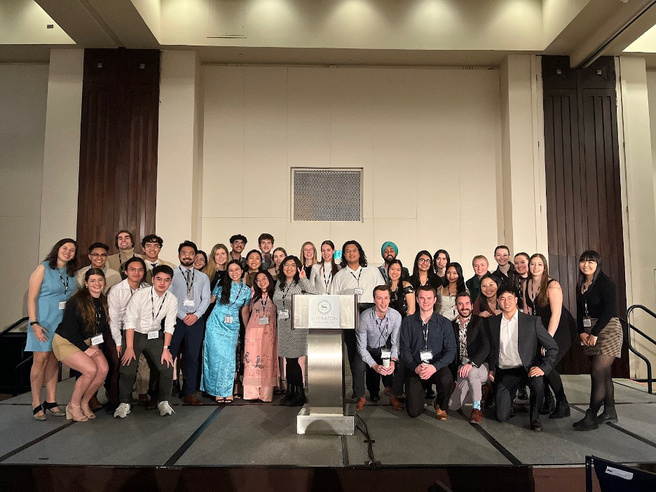
Pictured: U of M delegates at PDW 2024 in Toronto
National Advocacy |5
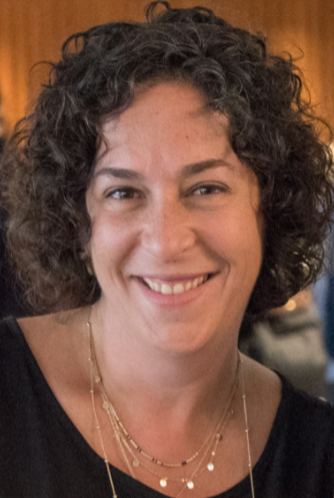
Dr. Patricia Gerber

Dr. Marianna Pozdirca

Jennifer Butler

Dr. Matt Glass
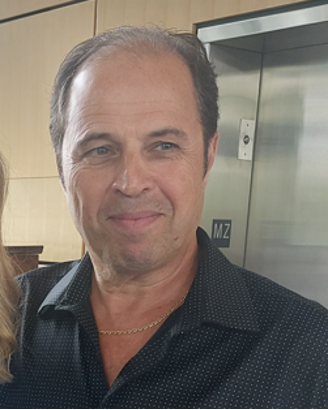
Dr. Robert Ariano
Leadership

Dr. Patricia
Gerber
PharmD, FCSHP, RPh
Educational Background:
Dr. Gerber obtained her Pharmacy degree from the University of British Columbia (UBC) in 1993. She completed a Pharmacy Practice Residency Program at the Children’s & Women’s Health Centre of BC in 1994, and obtained her Graduate Doctor of Pharmacy (PharmD) degree from UBC in 1997. Between 1994 and 2008 Dr. Gerber served as Clinical Pharmacist, Education Coordinator, and Residency Coordinator at the Children’s & Women’s Health Centre of British Columbia. Since joining the UBC Faculty of Pharmaceutical Sciences in 1994 on a part-time basis and in 2008 full-time, she has been teaching and providing educational leadership in entry-to-practice and graduate programs. She has served in numerous leadership and scholarly roles, including as Clinical Coordinator (2008-2015) and Director of the Graduate Doctor of Pharmacy Program (2015-2018).
In 2017 she designed and launched a leadership course in the UBC PharmD Program, which has been recognized with publications and invitations to speak at national and international conferences. Her teaching has been recognized with the 2011 University of British Columbia Killam Teaching Prize, as well as with multiple annual UBC Faculty of Pharmaceutical Sciences teaching nominations and awards. Dr. Gerber serves in a number of scholarly roles at the Faculty, nationally, and internationally. Her areas of interest, expertise and research are leadership, professionalism, and leadership identity development. She is currently the Director of Degree Programs for Pharmacists (the Flexible PharmD Program and the new Graduate Diploma in Pharmacy Leadership).
Current Role(s):
Associate Professor of Teaching and Director, Degree Programs for Pharmacists
Leadership | 7

Dr. Patricia Gerber
PharmD, FCSHP, RPh
What was the most important or hardest decision you've made in your career?
Quite early in my career, I was grappling with deciding whether to advance my skills by enrolling in a graduate program. At the time, the University of British Columbia (UBC) offered the Graduate Doctor of Pharmacy program as an avenue to enhance one’s clinical knowledge and skills. After considering whether I had what it took to embark in that challenging program, I enrolled in 1995. Through that program, I gained career-changing skills way beyond clinical ones: how to think critically and how to assert myself confidently yet vulnerably. These new skills opened many doors and opportunities for me in the years to come. So, my first message of advice to pharmacy students is to consider their pharmacy degree as a starting point in their careers; and, no matter where their journey takes them, to keep learning.
In 2017, when the UBC entry-to-practice PharmD program was just 2 years old, I designed a leadership elective course, something that had never existed in any of our previous academic programs. It was a big decision to propose that to the faculty leadership, and to embark on developing that. It was risky, like all decisions are! Why? Because launching something new always feels like a bit of a risk because it's new and exciting.
“Without risk-taking… there’s no growth.”
We all want to do things right, and we want to do amazing things! Yet, until we're down on that new path, we don't really know how things are going to turn out. Today, that leadership course is in its 7th year, and I love teaching and learning from my amazing small group of PharmD students. So, my lesson here is that my career taught me that hard decisions are hard to make, because we want some sort of reassurance that the outcome is going to be great, that it’s going to go as we expect or wish it to be. However, that’s never the case!. The outcome is never exactly like that: could be better, could be worse, but without risk-taking and making decisions to keep venturing forward and trying something new, there's no growth…and in order to get the opportunity to do cool things in our careers, we need to grow!
Do you remember a moment when you felt especially proud of yourself during your pharmacy career?
I’m humbled, but I'm proud of having led the design and development of the new UBC Graduate Diploma in Pharmacy Leadership that UBC just launched.
Leadership | 8

Dr. Patricia Gerber
PharmD, FCSHP, RPh
After some years of experience in both the clinical world and in academia, I started getting more comfortable with exploring areas that interested me for ways that I could contribute by bringing creativity and designing new initiatives. So it sort of happened organically … I learned that I enjoyed leading new ideas, proposing new visions, and seeing them to fruition.
As time went by and I found myself in my early leadership roles, I began signing up for leadership courses, webinars, conferences, all of which complemented and enhanced the skillet I was acquiring while I was jumping in to lead things, while I was learning as much from setbacks as from victories, and while I was carefully watching and paying attention to other leaders I admired. And now, I find myself in my current leadership role as Program Director of a program focused entirely on imparting leadership skills on pharmacists!
So, I guess the main lessons that my path taught me are that 1) without taking risks and ignoring our fear of setbacks we don’t learn or grow, and 2) the learning is life-long (I still take courses on how to be a better leader. Yes, the cliche that learning is lifelong is very, very true!
I'm proud of having led in a robustly collaborative way, not only by engaging with stakeholders and potential future employers of graduates of this program from across the profession, but also in collaborating with many amazing colleagues in the development of the curriculum. Designing a new program at a university and proposing it through many layers of internal and external approval is hard and challenging work. I'm very proud of the work we've done and the way that our work now provides a new avenue for pharmacists to develop or enhance their leadership skills.
Leadership in pharmacy is very integral to the way you navigate your career path. Tell us how you learned to be a leader.
This is a fun question for me because I never truly learned leadership deliberatively. It wasn't part of my plan, to be honest. Unlike today, when I was an early career pharmacists, formal opportunities for leadership development were few if any at all.
“What balance means to us is an ever-evolving concept that requires us to be reflective.”
Leadership | 9

Dr. Patricia Gerber
PharmD, FCSHP, RPh
How do you find balance between your life and career goals?
Speaking from the heart, as a mother and pharmacist, who for several years juggled roles in both clinical and academic settings concurrently, seeking a reasonable balance between life and career has always been a priority for me, and, I did not always get it right. What happens is that what we think of balance and how we value the idea of balance changes as we advance in our careers, as we grow as individuals, as we move through life. “Balance” was a very different thing for me when my kids were little than when they were in high school, or now that they are in university, and being a role model to them became an important priority for me. So what balance means to us is an ever-evolving concept that requires us to be reflective. I also learned that balance doesn't come down to how many hours you spend at work vs in your personal life or in your home life, but rather, in how you work, and in how you choose to spend your time, and in how you show up to whatever you do.
Unlike students today, who I think have great awareness of the importance of work-life, integration (which is a more appropriate word than balance), I learned it along the way, with victories, with hard times, with setbacks, with successes… and so much in between. So much of what your generation stands for is something that you already bring to the table in everything you do: an awareness of what it means to live a balanced life. I admire that.
Lastly, I invite you not to think of this topic as something that you achieve or arrive at, but rather, as an ever-evolving thing is that it's on you to continue to self-reflect about, it's on you to be aware that it's going to change all the time. It's on you to reassess, and to be honest with yourself.
Leadership | 10

Dr. Marianna Pozdirca
“Advocacy was an ever-present necessity all throughout my class’s journey as the first cohort in the new PharmD program.”

Throughout my pharmacy journey, my interest in law was further validated. My favourite (and best) class was Pharmacy Law. I worked for the College of Pharmacists for two summers, learning much of the regulatory landscape in our province. I started working for the Pharmaceutical Policy Unit at Manitoba Health. And, of course, advocacy was an ever-present necessity all throughout my class’s journey as the first cohort in the new PharmD program. Much of this advocacy was done through CAPSI, and although advocacy is a key pillar in law, I knew I wanted to do law long before I joined CAPSI National Council.
As a law student, I seek out areas where pharmacy (or health more broadly) and law intersect. For instance, I’m currently working with several classmates on a project -
for Pro Bono Students Canada and the Manitoba Harm Reduction Network (MHRN). This project focuses on providing legal information about potential liabilities involved with some aspects of harm reduction work. We work through legal questions but also touch upon a space where I find my pharmaceutical background particularly helpful, and I think this is just one example of where I’ll find ways to be helpful to communities by combining my two professions.
What inspires your advocacy work?
I think one of the things I’ve been accused of (and maybe something many advocates may be accused of) is negativity, because it seems somewhat pessimistic to constantly be focused on problems and shortcomings around us. I would challenge that notion though and put forward that advocacy actually arises out of optimism. I’m optimistic that our current system could be better. I’m optimistic that our profession could be better. I’m optimistic that our communities could be better. I was optimistic that our new PharmD program at UofM could be better. I was optimistic that student wellness could be better across pharmacy schools in the country, and we presented that optimism through CAPSI’s Student Mental Health and Wellness National Report in 2022, which sparked advocacy efforts across all pharmacy schools.
So, I think that what inspires lots of my advocacy work is that optimism that the experiences we go through and the experiences of our communities could be improved through solutions that are reasonably within our reach.
Educational background: PharmD Class of 2023, JD Class of 2026
Current role(s): CPBA Liaison (Pharmacists Manitoba Board of Directors), Community Pharmacist (Sobeys Pharmacy), STEP Student (Pharmaceutical Policy Unit, Manitoba Health), Research Assistant (Faculty of Law, University of Manitoba)
You are a recent graduate of the PharmD program and now studying law. How much of this transition can you owe to your experiences in CAPSI? Or was it something else completely?
Law was on my mind from a very young age. My parents placed a high value on education early on, and, when I was eight years old, I remember my mother asking me what I wanted to be when I grew up - a doctor or a lawyer? Being utterly terrified of blood, I said “absolutely not a doctor”. I didn’t know what lawyers do. My mom told me they read a lot, and I loved reading (granted, very different content matters from legal reading), so I felt law would be a good option.
Over the next several years though, I started to realize that no one in our family has done law, and my mind shifted to other career paths. My sister was practicing as a pharmacist, and I had the opportunity to live vicariously through her experiences. This made me feel like pharmacy would be a wonderful path to pursue, and I have no regrets about taking this road!
Leadership | 11

Dr. Marianna Pozdirca
I understand advocacy is sometimes painstakingly slow (though, not always!) and even isolating, but I do think that when we look back and when we unite to learn from counterparts across the country or across other spheres, there is also lots of past success that we can draw inspiration and learning from.
Do you remember a moment of feeling especially proud of yourself during your pharmacy career or studies?
There are many moments that I’ve felt especially proud - not necessarily of myself - but rather of our profession, our class, the teams I’ve had the opportunity to work with, and so forth. Although sometimes our journeys through pharmacy studies seem disjointed, my proudest moments are when we’ve been able to scaffold atop previous learnings.
During my APPE Primary Care rotation (my Block 2), my preceptor (shoutout to Jennifer Gibson!) taught me a lot about insomnia and tapering Z-drugs and benzos. At the time, we had several referrals from physicians in the MyHealthTeam clinics asking us to talk to their insomnia patients and try tapering their sleep medications. None of my attempts at this were successful. It turns out lots of the “insomnia” was actually other stuff - like narcolepsy or sundowning or pain mismanagement - in other words, all I learned about insomnia in isolation (though nothing really ever is truly in isolation from other health conditions) was not all that applicable to these complex patient presentations.
Somewhat discouraged, I still retained all the resources and clinical pearls Jennifer had given me (I recommend you try this! Make a Google Drive of resources you find helpful so you can come back to them and share them with your pharmacy friends :)). On my APPE Community rotation (my Block 6), I was at a fairly slow pharmacy and with an excellent preceptor. We quickly identified that I was looking to do more and came up with a project - BZRA deprescribing. My preceptor found a way to generate a list of all patients on BZRA’s and I was off to the races. This was my opportunity!!
During my day, I would make my way through the list, in addition to any refill requests or pick-ups, and engage in conversations about sleep with my patients. Often, I start these kinds of conversations with “I want to follow up on this sleeping pill you’re on, how’s it working for you? Is it working as well as it did when you started it? Do you notice any daytime drowsiness or grogginess?”
More often than not, these patients replied that their sleeping medication was not cutting it anymore or that they were experiencing side effects. I would then explain how the medication works and how tolerance can develop. Once they had more of an understanding of how sleeping drugs work and why they won’t cure insomnia, I would ask them to fill out a sleep diary and schedule follow-up with them.
I’m proud of this project because it empowered my patients to do something that they wanted to do (quit or reduce their sleeping medication) but didn't have support to do before. It let me work closely with many patients, especially older adults, over several weeks and hone in on my insomnia-related counselling. A patient on zopiclone 15mg came back a few weeks later on 7.5mg. Initially, I was floored - patients listened to me! A new face! A student! I was so excited to see these plans in action and working. Today, I’m still utilizing these skills I developed on rotation in practice. From new zopiclone starts, to creating tapering plans, to calculating sleep efficiency and counselling patients - it’s my favourite part of my day.
Where do you want to see pharmacy practice in Manitoba in the next 10 years?
Many of our discussions around pharmacy practice change center on the idea of practicing to the full scope of our education. I was recently having a discussion with a pharmacy leader in Quebec, Betrand Bolduc (fun fact: he was actually featured in the very first original Apothecary Volume 1 in 2020!) about the changes to practice they’ve brought in Quebec a few years ago, and he raised an interesting point about our “full scope of education” language.
He pointed out that, in the current system, the issue isn’t just that pharmacists aren’t working to their full scope. The issue is also that most primary care providers, including physicians and nurse practitioners and physician assistants are not necessarily practicing to their full education, when we have a system that cannot keep up with patient needs and does not open access for all health professionals to leverage their expertise.
“We could spend more time on prevention, rather than lagging one (or more) steps behind our community’s needs.”
Leadership | 12

Dr. Marianna Pozdirca
Physicians are not practicing to their full scope, when the current system demands that they dedicate time to self-limiting conditions that pharmacists can prescribe for or clarifying prescriptions that pharmacists could easily fix for patients faster. It’s not just pharmacists - there are many health care providers that we have not “freed up” to truly practice in the way their training has prepared them. I’m not talking about freeing physicians from just administrative burden (though that’s important). I’m talking about freeing up some of our physician and NP colleagues’ time by helping manage chronic conditions and caring for self-limiting or acute conditions, so that they can see the patients that need to see them faster, before their conditions become more complicated. In a system like that, we could spend more time on prevention, rather than lagging one (or more) steps behind our community’s needs.
Over the next decade, I’d like to see all healthcare practice in Manitoba more integrated through our electronic records and information sharing, so that if a patient sees their family physician for a new prescription, community pharmacies within the circle of care of that patient can also access indications, lab values, and notes to understand treatment rationale. Today, we don’t have eChart access - we could start with that - but even eChart access alone wouldn’t necessarily solve the fragmentation of information within our digital systems.
Alongside that, I’d like to see government investments into community pharmacy care services, so that patients do not have to pay (and neither should pharmacies be expected to absorb costs) for minor ailment assessments (the same way they don’t have to pay for UTI assessments! We’ve done this before!), continued care prescriptions, smoking cessation counseling, medication reviews, deprescribing, lab test ordering, and so forth.
We often focus on the next shiny regulatory change we can advocate for, but our regulations are not the barrier to practicing any of the above services - which are incredibly valuable for patients’ health!
“The care we provide as pharmacists should be meaningful and strategic for our patients.”
These are all things that we should be able to do, but there’s no framework (no compensation model, little information sharing, inconsistent demand and availability of pharmacist services, etc.). I believe we should be building the framework to offer all that we currently can before (or at least alongside) asking for more regulatory changes.
However, when we do (and we should) pursue regulatory changes and implementation frameworks, they should be for all pharmacists. There is no reason that the same pharmacist prescribing for a UTI in a community pharmacy should be prevented from prescribing for the same UTI in an Access Centre or MyHealthTeam primary care clinic. Whether or not they choose to (i.e. whether it fits with the rest of their practice) is a different question - one up to that pharmacist to decide. In the same vein, all pharmacies are primary healthcare centres - regardless of whether we call them clinics or have a shiny new waiting room or consultation space.
The care we provide as pharmacists should be meaningful and strategic for our patients. Although all the services we offer are valuable in general, not every specific patient will need a prescription or a lab test ordered or a medication review or even deprescribing. As the financial model of pharmacies shifts from dispensing to these services, our patients are best served by quality over quantity.
I’m not so naive as to think that funding will not play a role in this. After all, there’s a reason many of our pharmacies do way more UTI assessments than minor ailment assessments (hint: it’s funding). But the long-term sustainability of these services - not to mention the health of our patients and communities - will depend on us offering the right service at the right time.
Do you EVER get tired!? Give us the recipe for your energy potion please!
I feel like this is people's biggest misconception about me. Of course I get tired! I’m tired right now. But I’ll let you in on my secret, here is my “go-to” energy potion:
Step 1: Go to your nearest Starbucks
Step 2: Order 4 shots of espresso, 4 shots of white mocha
syrup over ice in a grande cup
Step 3: Drink this ghastly combination
Step 4: Energy restored
Please drink responsibly :P
Leadership | 13

Dr. Matt Glass
Educational Background: PharmD Class of 2023
Current Role: Staff Pharmacist Shoppers Drug Mart
As a recent grad, what has stood out to you most about being a practicing pharmacist? Have there been any surprises since you entered into the “real world” of pharmacy work?
The thing that has stood out the most for me in Community Pharmacy has been the impact you’re finally able to make in the care for so many people. Now that all the clinical and patient inquiries need to run through you as the pharmacist, the job is that much more rewarding and satisfying compared to the time spent working/on rotations in school. The biggest surprise once I finally got licensed didn’t really have to do with the patient care aspect of things, it was all the “other” daily tasks you never had to deal with being on rotations; like managing inventory, handling recalls and incident reports, preparing methadone, etc. Even though the last year of rotations prepares you well for most things you need to practice, it was surprising with how many extra things the pharmacist was responsible for.
Was there a moment in your pharmacy career or studies that defined how you practice today?
I think the amount of time I was able to spend with so many different pharmacists over the course of my rotations was the most beneficial thing for my current practice. Seeing how each of them operate and what they strived for with their patients, allowed me to hand-pick the qualities I also valued and allowed me to evolve my practice. Each of the pharmacists I encountered on my rotations had such a high level of knowledge for their practice which really can enhance the care your able to deliver. In addition, there seemed to be a consistent theme of going the extra mile for each and every patient if you are able to. For an extra few minutes of time you can provide, it can really make the difference to your patient and they will value your help that much more.
Leadership | 14

Dr. Matt Glass
What do you consider to be your most important memory from being a student?
Although class was fun at times, it was all of the events that pharmacy school put on that helped make the best memories. Whether it was a student night at the Bomber game, going on trips to PDW when we were able to, or even just going out for food to celebrate finishing our final exams. These are some of the things you look back at after school is done and where the better connections with classmates were made. As important as class was, it was more important to take breaks and enjoy the time you had outside of the classroom otherwise it would have been easy to burn out over the course of Pharmacy school.
How do you find balance between life and career goals? Do you think you can have one without the other?
I think the best way is to carry the same attitude over from school and instill that into your future job. After graduation it can be easy to get caught up and wanting to work as much as you can to make money to pay off debt/save for house/go on trips and what not.
Putting time aside for life outside of work over the course of the week is just as important as your work schedule.
Putting time aside for life outside of work over the course of the week is just as important as your work schedule. Granted, it is MUCH easier now that the burden of needing to study is over and there is a lot more free time (which can be a problem in itself trying to find new hobbies haha).
Tell us about a noteworthy patient care experience you’ve had as a pharmacist.
There have been a few that have stood out to me, but one stood out with an elderly patient who was suffering adverse effects from a low dose of mirtazapine. They were using it for anxiety/sleep and were experiencing significant next day drowsiness to the point they were a bit delirious, which was concerning for most of the family. Most of the family/care team were thinking about going down on the dose/switching the med as a result. After touching base with the family/doctor and explaining the receptor selectivity for mirtazapine (more sedating at lower doses), everyone reluctantly took my recommendation to increase the dose for a week and to monitor how the patient was doing. Within days, the patient's side effects disappeared, their daily functioning improved and the family went out of their way to come by the pharmacy to see me and say thank you. This was a good reminder to me that working in community pharmacy provides a great opportunity to make a difference and form connections with as many people as possible.
Leadership | 15


Educational Background: BScPharm – University of Manitoba, Residency in Hospital Pharmacy – Ottawa General Hospital, Pharm.D. from the University of Minnesota, Board Certified Pharmacotherapy Specialist, Fellow with the American College of Critical Care Medicine
Current Role: Clinical pharmacy specialist in critical care at St. Boniface Hospital.
What is your leadership style? Do you consider yourself a leader to others in your area of practice? How do you demonstrate self leadership?
I never think of it as leadership style; moreover, as a passion for seeing where pharmacists can offer a unique contribution to health care. My drive and determination to encourage and lead others comes from seeing that end in mind.
Was there a moment in your pharmacy career or studies that defined how you practice today?
My moment came as a Pharm.D. student at the University of Minnesota in Minneapolis. While on clinical rotation at St. Paul Ramsey’s hospital; I was precepted by Dr. Rob Sylvester.
Dr. Robert Ariano
I already knew him well as our professor for the Oncology portion of our Pharm.D. program. On this day, however, he was the pharmacist on call for the emergency room; when he asked me to join him for a cardiac arrest code. We quickly rushed to the emergency room and he started to prepare drugs for administration. Once he saw the EKG rhythm on the monitor, he announced to the team that we should consider starting atropine first. The team looked at him, but then turned and continued with CPR not responding at all. He then turned to me and quietly announced that in the latest version of the ACLS guidelines they are recommending atropine in this situation as the rhythm of asystole may simply be that of severe bradycardia. I could see them intently listening to him while he was teaching me; and then they abruptly stopped and said, ‘okay we should try atropine next’. It had taught me the quiet confidence and strength in being knowledgeable in stressful situations; and delivering your message in a direct, non-confrontational way.
What do you consider to be your most important memory from being a student?
As an undergraduate student at the University of Manitoba I had come across some very impactful practicing pharmacists. My most memorable recollection was being a student on community rotation with Vern Cooke from a Main street pharmacy. His passion for pharmacy and helping people was so natural and inspiring.
What is your motivation? What inspires you to push yourself in your field?
If you’re truly thinking of the patient under your care and their needs; no other motivation is necessary.
Leadership | 16

Dr. Robert Ariano
I’ve never grasped statements like, ‘what if it was your father, or your mother needing treatment’! That’s irrelevant; as you should treat all patients with the same drive and determination to get them better. If you have to draw upon theoretical family members in these situations for motivation; this is not a career path for you.
It really comes down to seeing the unmet need in patients, and trying to find the best way to address those needs. Too often pharmacists only ‘react’ to questions that come from the health care team thinking that they are somehow helping. You shouldn’t be sitting back and reacting; when you should proactively be thinking of questions that only you can ask and address. This is where professional synergy comes in. Nurses, physicians, and pharmacists all have their own unique contributions to health care team; with the sole purpose of the patient’s wellbeing in mind.
Is there anything you feel particularly passionate about right now in your area of work that you’d like to share?
I’m a strong proponent for bringing precision medicine to the bedside. This means that all of drug selection and dosing can be guided by the unique characteristics for each patient (i.e. their age, gender, body weight, and genetics), as well as external factors such as drug interactions and comorbidities specific to that patient. With the advent of pharmacogenomics, we can know in advance which patients will be fast or slow metabolizers for that drug. This advanced knowledge can help minimize that initial trial and error period, so often brought about by exposing a patient to ‘average’ doses recommended by the manufacturer.
The future will be to start dosing regimens; which will match patient’s metabolic status more precisely. Additionally, by using measured blood levels and computer modeling we can further guide drug dosing to more accurately optimize drug efficacy and minimize adverse reactions over time.
Unfortunately, there is a strong tendency to want to simplify medication therapy by using a ‘one-size’ fits-all approach to dosing; in other words, they’re designed for the ‘average’ patient. This goal has often failed patients on the margins within the general population, but is still attempted to this day. You should proactively be thinking of questions that only you can ask and address.
In fact, I would argue that those margins are wider than we think, because of those differences and complexities in patient demographics, comorbidities, and concurrent drug therapy. One way that manufacturers has gotten around this variability in clinical exposure to a one-dose fits-all philosophy; is to, for example, contraindicate it in those with severe kidney dysfunction, or state something like, it hasn’t been studied in patients over 120 kg. We’re basically playing pharmacologic roulette with patients that don’t quite fit that ‘average’ mold! My goal for precision medicine is to basically target ‘therapeutically-proven’ optimal exposures for all patients. Logically, this is the future for pharmacy and medicine; and we should be planning for it now.
You should proactively be thinking of questions that only you can ask and address.
Leadership | 17

Jennifer Butler
Educational background:
I completed 3/4 years of a bachelor's degree with a joint major in microbiology/biochemistry at l'Universite de Saint-Boniface before being accepted into the Class of 2018 at the College of Pharmacy in the Max Rady Faculty of Health Sciences at the University of Manitoba.
Current role(s):
I am a board director and the Vice President for Pharmacists Manitoba, the Manager of Professional Practice at SpiritRx Services, which provides for people living in remote communities in Northern Manitoba. I manage a team of 9 pharmacists and 3 listed technicians.
How would you describe your leadership style, and how do you address leadership in your personal life?
In the past, I've naturally found myself to be a task-oriented leader; I was always good at getting things accomplished, but this often came at the expense of the relationships with people with whom I was working.
Someone once told me that if you focus only on your strengths and ignore your weaknesses, your strengths become your weakness. In my case, my strengths were getting things done, and my weakness was showing the people I worked with that I cared. As I've gotten older, I have shifted my focus to prioritize fostering strong relationships with those I lead. As I can trust my ability to deliver results, I now place emphasis on regularly engaging with my team to support their success.
Leadership | 18

I have gained insight into my personal values, emotional regulation, and effective
leadership skills.
Concerning my self-leadership; Therapy! As a pharmacist, I'm grateful that I'm able to financially prioritize investing in my personal and professional development through therapy, which has positively impacted my approach to work and life. Through therapy sessions and recommended readings, I have gained insight into my personal values, emotional regulation, and effective leadership skills. For students facing financial barriers to therapy, I suggest exploring options such as student benefits, university support programs, or utilizing free resources such as library books and podcasts.
What are three things you would like to tell your former student self?
Well the thing I said earlier about strengths and weaknesses for sure. But if you're looking for three others: (i) prioritize leading with kindness, (ii) failure can lead you to where you need to be, and (iii) stop spending so much money on makeup.
When was a moment in your career that made you proud about your work as a pharmacist?
I once had a patient come to me seeking a medication review. They explained that they had been dealing with chronic pain since an accident several years ago, and their previous prescriber had retired. They were being referred to a physician at a pain clinic for their upcoming appointment and wanted to prepare themselves beforehand.
The patient shared their concerns about advocating for themselves with healthcare providers and feeling anxious about the new appointment. They felt they had some control over managing their pain after years of struggle and were worried about potential changes. To assist the patient, I stayed late to compile a report summarizing their healthcare and pain management history, emphasizing key information for the new physician. Following the appointment, the patient informed me that the physician acknowledged how the report significantly impacted the visit. Despite initially considering a more cautious approach due to limited familiarity with the patient, the physician was able to develop a more informed plan, alongside the patient.
These moments, where patients feel listened to and supported, are what inspire my passion for this profession.
Leadership | 19
National OTC Winner
BioScript CAPSI Leadership Award Winner
Simranpreet Dhaliwal
Year 4
Have you always enjoyed doing OTC topics?
I enjoy OTC topics because I counsel on OTC products almost every time I work at the community pharmacy. I feel happy when I can help customers by using the knowledge I have gained through APPL and Clinical courses.
Do you think you have a special strategy that helped you secure the win?
I seriously didn't use any strategies. I knew my assessment had to be strong to give the correct product. I always use the SCHOLAR method for the OTC assessment, and I think I used that during my OTC competition, which helped me win.
Reflect on your shining moment. How did it feel to have your name announced for this award?
Honestly, I wasn't sure If I was going to win. When the announcer read the second and the third positions, and it wasn't me, I thought I did not win the OTC competition. I clearly remember I was looking at my phone when they announced my name, and I was in shock. Then I heard my classmates cheering for me, and with my heartbeat rising, I went to the stage and accepted my certificate.
It felt surreal. In my head, I said to myself my hard work paid off.
Madison Wong
Year 4
What’s something that’s been special for you about being CAPSI President?
Getting the chance to work with such an incredible council! The best part of being involved in CAPSI National is getting to know some of the most passionate and hard-working pharmacy students from across Canada. Seeing our entire council together during PDW made me so happy.
What was your favourite part of the night of the award?
Having Marianna show up out of nowhere to help present my award! As you may or may not know, Marianna was President of UMPhSA the year I was Pres-Elect of UMPhSA, and she was also an exec member of CAPSI National the year I was Pres-Elect of CAPSI. She’s now graduated and for all I knew was in Hawaii during PDW. So, it was incredibly special when Christine (CAPSI Past-Pres and another UofM alum) invited Marianna up on stage to co-present this award to me. I was so surprised and moved at the same time, I could’ve cried.
This is basically like an Oscar but for pharmacy students — where does the award live as its place of honour?
For right now it’s sort of just sitting as part of centrepiece on my dining room table haha. I don’t think it’ll stay there, it’s where I put it to show my family when I got home from PDW, and it just hasn’t moved since.
I was so surprised and moved at the same time, I could’ve cried.
Student Spotlights
Student Spotlights | 20
CNTP Winner
Wyatt Baloun
Some are saying the win was not a one-man effort. In your opinion, did Brad give you the edge you needed to secure the crown?
The crown is as much mine as it is Bradley's. Without him, the song would never have been written or performed. To say that Brad "gave me the edge I needed to secure the crown" would be an understatement. To go beyond that, Brad and I could not have done it without our friend Noah Brown who professionally recorded and produced the song for us.
What was the first thought that went through your head when they announced you as the winner?
My first thought was "Shoot, did I leave a load of clothes in the washing machine back home in Winnipeg?" More accurately I was probably thinking about how cool of a win this is for Manitoba.
What was your strategy? Did you feel like you were particularly well suited to a certain part of the competition?
My strategy was to have fun out there. I did practice my catwalk in front of the mirror in the hotel bathroom many times.
Student Spotlights | 21
Wellness Resources at The U of M
Student Services, S211 Medical Services Building, serves as a hub for programs and
supports on campus. You are welcome to drop by or call to connect with services.
Services are free of charge.
Student Advocacy
Provides confidential support for students who are facing challenges, seeking aid regarding a complaint or have a concern regarding University of Manitoba matters. Students are able to utilize a Student Advocate in meetings with administrators or Professors, as well as receive aid in preparation of discipline or academic meetings.
Matthew Carvell, Student Advocate at Bannatyne.
Matthew.Carvell@umanitoba.ca
204-474-7423
Academic Learning Centre
Students and residents are invited to make an appointment with a writing or study skills tutor or attend workshops in order to further develop academic strengths and skills in writing, learning and research.
204-272-3190
Additional Services Include:
Financial Aid and Awards, Academic Integrity, Health and Wellness Educator, Spiritual Care Coordinator.
Counselling Services - confidential
Counsellors working specifically with the Rady Faculty of Health Sciences, supporting students at Bannatyne campus. Personal counselling is available for anxiety, depression, relationship problems, stress, loss, transition, trauma and violence, and procrastination, among other concerns.
204-272-3190
Student Accessibility Services
Support and accommodations Provides support and advocacy for students with disabilities, such as: hearing, injury-related, learning, mental health, medical, physical, visual or temporary disabilities. Advisors act as a liaison between students, faculty, staff and service agencies.
student_accessibility@umanitoba.ca
204-272-3190
Sexual Violence Resource Centre
The Sexual Violence Resource Centre can meet by phone or come to Bannatyne for in-person meetings.
svrc@umanitoba.ca
204-474-6562
Career Services
Students, residents and recent alumni can get assistance with career planning, career exploration and job search. Harpreet is available to provide career advising to Bannatyne students in-person, via online video, telephone and email.
204-474- 9456
International Centre Advising
Support for navigating internal and external systems The International Centre’s student advisors can help you adjust to life in Canada, plan ahead or work through challenges regarding personal matters, academics, university regulations, visas, permits and immigration.
541 UMSU University Centre
University of Manitoba (Fort Garry campus) international@umanitoba.ca
204-474-8501
Wellness | 22
How are Pharmacy Students Staying Well?
Year 1
- Anna Le collects sonny angels
- Evelyn watches TV (currently Glee)
Year 3
- Shaelyn hangs out with friends
- Jen walks her dog
Year 2
- Justin plays video games
- Hannah goes for a run
- Maddy G goes to the gym
- Corrine listens to music and dances around her kitchen
Year 4
- Our year 4 students are staying well in many ways off campus ;)
Wellness | 23

Recipes From Our Pharmily
to Yours
Chicken Packets
Submitted by: Laura-Lee Bouchard

Ingredients:
- 2 cups of cooked, shredded chicken
- 1/2 cup of crushed and seasoned croutons
- 1-3 ounces of softened cream cheese
- 2 packages of refridgerated crescent rolls
- 1 tbsp of chopped chives
- 1/4 cup of melted margarine
- 2 tbsp of milk
- Salt to taste (optional)
Grind up croutons into crumbs, use a rolling pin or the back of a large spoon to “smash” them. Place crushed croutons in a shallow container. Melt margarine and place into a separate shallow container.
Preheat oven to 350°F and line a baking sheet with parchment paper.
Mix shredded chicken, cream cheese, chives, milk, and salt in a medium bowl (mixing with hands tends to work the best) to make the filling.
Unroll crescent rolls (each tube will contain 4 rectangles of dough with a diagonal perforation). Press dough along the perforations so the halves do not separate. Place about 1/4 cup of the filling into the center of each rectangle. Fold the dough over the filling and pinch the edges to seal tightly.
Dip each packet in the melted margarine, and then coat with crouton crumbs.
Place packets on the baking sheet and bake for 20 minutes or until golden brown.
You can freeze the filling in a 1 quart freezer bag for later use. Thaw before preparing packets.
They are delicious hot or cold!
To double the recipe - use 4 chicken breasts, 2 bricks of cream cheese, and 5 packages of crescent rolls.
Snacks | 25
Mandarin Spinach Salad
Submitted by: Laura-Lee Bouchard
Ingredients:
- 1/4 bag (10oz size) fresh spinach
- 1/4 head of romaine lettuce
- 1 cup chopped celery
- 2 green onion stalks chopped
- 1 can (284 ml) mandarin oranges (drain)
- 1/4 cup slivered almonds
- 3 tbsp. sugar (1 tbsp. to candy almonds, 2 tbsp. for dressing)
- 2 tbsp. vinegar
- 1/2 cup olive oil
- 1/2 tsp. salt
- Dash of pepper
- Dash of tabasco sauce or any hot sauce
- 2 tbsp. chopped parsley
In a container with a tight-fitting lid combine 2 tbsp of sugar, vinegar, olive oil, salt, pepper, tabasco sauce/hot sauce and parsley to create the dressing.Shake well and refrigerate.
In a small frying pan combine almonds and 1 tbsp of sugar, cook over low heat stirring constantly until sugar is melted and almonds are well coated. The almonds really make the salad! Don’t be afraid to double the almonds! Spoon the almonds onto parchment paper or a large plate.Cool and break apart.
In a large bowl add bite size pieces of the spinach and romaine lettuce. Add celery, green onions and toss. Set aside.
Drain the mandarin oranges.
When ready to serve combine the oranges and almonds to the greens and toss, add the dressing and serve.
Yields 4 to 6 servings.
Snacks | 26
Quick and Easy Turkey Burgers
Submitted by: Melissa Stamm
Ingredients:
- 1 lb. ground turkey
- 1 chopped red bell pepper
- Salsa (measured with your heart)
- Garlic powder (measured with your heart)
Preheat oven to 375°F.
Add all ingredients to a large mixing bowl.
Mix with hands and shape into patties (recipe yields 4 servings).
Bake patties for 30 minutes or until cooked through on a parchment lined baking sheet.

Savoury | 27
Slow Cooker Chili
Submitted by: Melissa Stamm
Ingredients:
- 1 lb. extra lean ground turkey
- 1 medium red bell pepper chopped
- 1 yellow onion chopped
- Garlic powder (measured with your heart)
- 2-4 tbsp. of chili power (if using a mild brand start on the high end)
- 2 tsp. ground cumin
- 1 tsp. dried oregano
- 1/4 tsp. cayenne pepper
- 1 28oz can of diced or crushed tomatoes
- 1 1/4 cups of chicken broth
- 2 15oz cans of dark red kidney beans, rinsed and drained
- 1 15oz can of sweet corn, rinsed and drained
- Top with choice of cheese, avocado, tortilla chips, cilantro, sour cream, plain greek yogurt
Cook the meat in a frying pan, add garlic powder to season the meat.
While the meat is cooking, chop the onion and the red bell pepper.
Once the meat is cooked, add everything to a slow cooker and cook for 4 hours on high or 6-8 hours on low so the flavours can blend together.
Scoop into bowls and serve with preferred toppings.
Savoury | 28
Viet Vermicelli Noodle Bowl with Lemongrass Chicken
Submitted by: Corrine Quo
Ingredients:
For the salad:
- 7 oz of vermicelli rice noodles (soak according to package instructions)
- 2 cucumbers cut into thin sticks
- 1 carrot grated or cut into thin sticks
- 2 cups of fresh bean sprouts, rinsed and drained
- 1/2 bunch of fresh mint leaves, roughly chopped
- 1/2 bunch of fresh coriander leaves, roughly chopped
- 1/4 cup roasted peanuts, roughly chopped
- nuoc mam (viet salad dressing)
Lemongrass Chicken:
- 2 lbs. boneless, skinless chicken thighs
- 1 lemongrass
- 1/4 onion, roughly chopped
- 3 gloves of garlic
- 1 tbsp. of fish sauce
- 1 tbsp. soy sauce
- 2 tbsp. brown sugar
- 1 tbsp. neutral tasting oil (sunflower, grapeseed, olive)
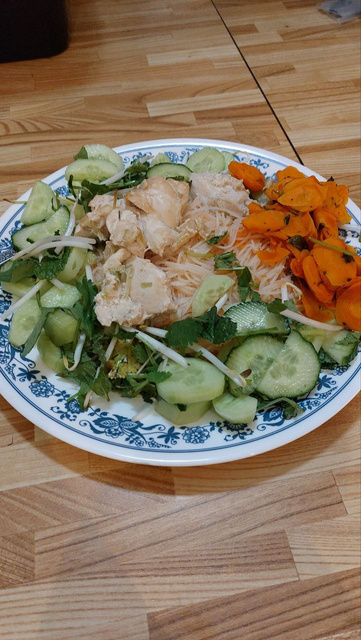
Wash and trim lemongrass (only use thick part). Finely slice then pound lemongrass until fragrant, then add garlic and onion and pound until a dry paste is formed.
Place lemongrass mixture into a large mixing bowl. Add fish sauce, soy sauce, sugar, and oil. Mix well then add chicken thighs and coat chicken well with the marinade. Cover and let marinate in the fridge for 1 hour - overnight.
30 minutes before cooking, take the marinated chicken out of the fridge for even cooking.
Preheat oven grill/broiler to 450°F and place chicken thighs on a foil-lined baking tray and broil for 25 minutes or until cooked and lightly charred.
Line bowls with vermicelli noodles, then top with other ingredients then add chicken.
To serve sprinkle chopped peanuts and drizzle with nuoc mam.
Savoury | 29
Waffles with Vanilla Sauce
Submitted by: Kezra Gerbrandt
Ingredients:
Waffles:
- 1 1/2 cups of flour
- 1/2 tsp. salt
- 1 tbsp. baking powder
- 1 tsp. baking soda
- 1 egg
- 2 egg whites (save yolks for sauce)
- 1 3/4 cups of buttermilk
- 5 tbsp. neutral oil
Vanilla sauce:
- 2 1/2 cups of milk, divided
- 4 tbsp. flour
- 2 tbsp. sugar
- 1/8 tsp. of vanilla powder or 1 tsp. of vanilla extract
- 2 egg yolks
Preheat waffle iron.
Combine dry ingredients in a medium mixing bowl.
Add buttermilk, oil and eggs; whisk until smooth (with handheld mixer). It will rise as it sits for a minute. Do not stir down as you scoop out and into the waffle iron.
Spread the batter onto hot waffle iron. (leave room around the edge for the batter to spread) You may want to spray with oil or wipe the Teflon with an oily paper towel, just before cooking the first waffle. It should be fine then for the rest of the batch.
In a small pot, heat 2 cups of the milk until it begins to boil (medium heat).
While the milk is heating, mix dry ingredients in a small bowl, add just a little of the reserved 1/2 cup of milk, whisk the egg yolks in well, and then the rest of the 1/2 cup milk.
Stir mixture into the boiling milk in the pot just as it begins to boil up (you will see a skin forming) whisk until the sauce begins to bubble and thicken.
Remove from heat and top waffles with sauce to serve. Makes approx. 5 servings
Sweet | 30
Sugar Cookies
Submitted by: Anushka Kothari

Ingredients:
- 1 lb unsalted butter, softened
- 1 cup cornstarch
- 1 cup icing sugar
- 4 cups all purpose flour
Preheat oven to 350°F
In a large mixing bowl, cream together the softened unsalted butter and icing sugar until fluffy.
Add the cornstarch to the butter anad sugar mixture and mix until well combined.
Gradually add all purpose flour to the mixture and knead until it forms into a smooth ball.
Roll dough into 1/4 inch thick sheet, cut out into desired shapes.
Bake for 12-15 minutes or until the edges are lightly golden.
Once completely cooled, decorate with icing of choice.
Makes approx. 60
Sweet | 31
Brown Butter Toffee Cookies
Submitted by: Allanah Climaco
Ingredients:
Cookies:
- 1 cup unsalted butter (227g)
- 1/2 cup white sugar (100g)
- 1 cup dark brown sugar (200g)
- 1 1/2 cup all purpose flour (190g)
- 1 cup bread flour (127g)
- 1 tsp baking soda
- 1 tsp salt
- 1 tsp espresso powder
- 1/2 tsp baking powder
- 2 large eggs
- 1 egg yolk
- 2 tsp vanilla extract
- 283g semi sweet chocolate chopped
- 1 cup homemade toffee bits OR 1 cup skor
- flaky sea salt
Homemade Toffee Bits
- 1/2 cup unsalted butter (113g)
- 1 cup light brown sugar (200g)
- 1 tsp salt
Cookies:
Brown the butter on the stove, add white sugar, brown sugar, and butter into a bowl and let cool.
In another bowl, add both flours, baking soda, salt, espresso powder and baking powder.
To the cooled butter, whisk in eggs, yolk and vanilla.
Fold in flour mixture to the wet ingredients 1/3 at a time
Refrigerate dough for 24 hours in the bowl or separate into balls and freeze for at least a few hours.
If refrigerated, let dough sit at room temp for 1 hour prior to rolling balls.
Bake 350°F for 11 minutes. Remove from oven and sprinkle with flaky sea salt.
Toffee Bits:
.Line baking sheet with parchment paper. Melt butter in a pot over low-medium heat. make sure your heat is low-medium as if it is too high, this will not work!
Add sugar and salt and whisk vigorously for 1 minute, then let cook for 10 minutes or until 295-305°F.
If mixture separates at all, remove from heat and whisk vigorously until recombined then return to heat.
Once ready immediately pour the toffee onto the baking sheet and let cool for 20 minutes.
Sweet | 32
Thank You!
We appreciate everyone that submitted recipes, all those we were able to interview and everyone in between that has supported this year’s edition of the Apothecary.
From your Editor,
thank you.
